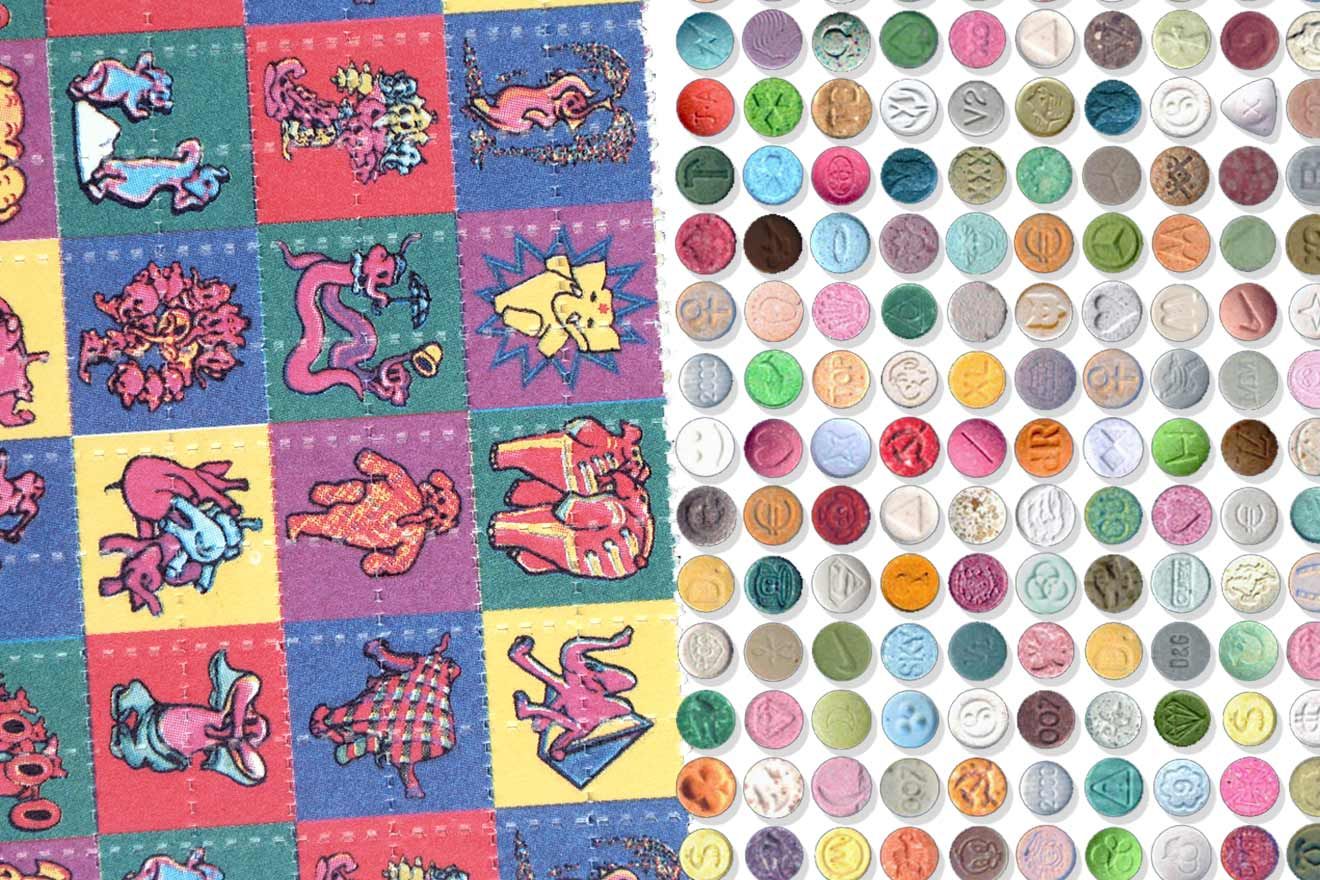MDMA and LSD are both considered psychedelics but with key similarities and differences. Both are experiencing a re-emergence in medical research as we grow to understand their therapeutic potential. Let’s compare the physical, mental, and therapeutic effects of LSD and MDMA.
LSD stands for lysergic acid diethylamide, while MDMA is 3,4-methylenedioxy- methamphetamine. Both are known for their psychotropic effects, and more recently as increasingly legitimate adjuncts to therapy. But where do these compounds come from?
The Origins of LSD and MDMA
As engineered substances, the origins of LSD and MDMA are somewhat similar. Both compounds were lab-created in the first half of the 20th century. After their effects were discovered, LSD and MDMA were researched in psychotherapy before being outlawed by the US FDA.
MDMA was synthesized by Merck, a German pharmaceutical company, in 1912. Merck was trying to create a clotting medication in competition with Bayer’s Hydrastanin. But Merck didn’t realize what they’d made until much later. In 1927, they began testing with animals after one chemist noticed MDMA’s chemical similarities to adrenaline [1].
Follow your Curiosity
Sign up to receive our free psychedelic courses, 45 page eBook, and special offers delivered to your inbox.LSD was created in 1938 by Swiss chemist Albert Hofman. He was searching for a new treatment for postpartum hemorrhage, but didn’t realize what he’d discovered until years later. After coming in contact with a small dose, he experienced its hallucinogenic effects [2].
By the end of the 1940s, LSD was being experimented with in psychotherapy. The US Army and CIA famously tried to use LSD as a truth serum and a method to incapacitate enemies, without success [2].
Both MDMA and LSD were used in psychotherapy in the middle of the 20th century. But when their use increased among the counterculture scene, the DEA scheduled them as controlled substances. Research on psychedelic therapy using MDMA and LSD immediately became more challenging, and slowed to a trickle.
What are the physical effects of LSD and MDMA?
LSD is called a “classical hallucinogen”. Along with psilocybin, mescaline, and DMT, it has had the greatest influence on the science and culture of psychedelics. MDMA is classified as an “entactogen” or “empathogen”.
Most classical psychedelics attribute their pharmacological effects to action on the 5-HT system. This is short for 5-hydroxytryptamine, or serotonin. LSD acts as an agonist on 5-HT2A receptors, which are concentrated in the frontal cortex of the brain. They’re also densely found in the claustrum of the visual cortex, as well as the limbic system and basal ganglia [3].
The location of these active serotonin receptors may be a clue to how LSD on vision, cognition, and integrative functions [3]3. Actived 5-HT2A receptors in the central nervous system also increase body temperature and stimulate ACTH secretion, which could explain how these psychedelics change our response to stress [3].
MDMA increases serotonin release through a different mechanism. It binds to the reuptake proteins (SERT) that normally take serotonin back into the neurons. Then, it reverses them to release greater amounts of serotonin (as well as dopamine and norepinephrine).
This increased neurotransmitter release has many downstream effects. MDMA also binds to 5-HT2A receptors but to a much lesser extent than LSD.
5-HT2A receptor activation creates some similar physical effects between the two substances. LSD and MDMA increase hemodynamics by raising heart rate. They both also increase core body temperature, and lead to dilated pupils and other autonomic responses [3]. However, it remains unclear the role of dopamine and norephrine in vital sign changes induced by MDMA.
Activating 5-HT2A receptors also affects the peripheral systems. It’s believed that these receptors also stimulate smooth muscle contractions in the gut, and more research is needed on this link [4].
Other substances that work on the 5-HT2A receptors include some antipsychotic drugs. Clozapine & Olanzapine, both used to treat schizophrenia, are examples of newer drugs that act as antagonists on these receptors [3]. While LSD and other classical psychedelics stimulate these receptors to create hallucinations, these antipsychotics depress the same receptors to block unwanted hallucinations.
What are the mental effects of LSD and MDMA?
While MDMA and LSD both cause psychedelic effects, they offer distinct experiences to users.
In comparative studies, LSD users rated higher on the 5 Dimensions of Altered States of Consciousness (ASC) scale, as well as the Mystical Experience Questionnaire (MEQ) [2]. LSD’s effects lend more into the visual and auditory alterations and mystical than MDMA’s [3].
LSD has greater subjective effects in several other areas. Ego dissolution, introversion, emotional excitation, anxiety, and inactivity have all been noted to a greater extent in people who use LSD. It also creates more impairment in subjective range of concentration, sense of time, and thought speed compared to MDMA [3].
MDMA has more excitatory effects as a psychostimulant and is less hallucinatory. It also leads to an increase in sociability, and creates more feelings of closeness than LSD. MDMA has more effect on oxytocin concentration in plasma, which could explain its effects on empathy and trust in a social setting.
For these reasons, MDMA therapy has more potential benefit in the group setting than other psychedelics, and it’s also much more associated with misuse in the party setting from its stimulant (dopamine) effects.
How common are LSD and MDMA?
The mental effects of both substances make them interesting substances for recreational contexts. It could also be that the ongoing legitimization of both substances makes them more appealing for people who wouldn’t have tried them before.
Statista estimates that national use of LSD and MDMA are fairly comparable, and they’re both fairly rare in the general population [5]. In 2020, it’s estimated that about 2.6 million people had used LSD or MDMA in the last year [5].
LSD use jumped over 50% between 2015 and 2018. Some scientists attributed this rise to a more “bleak” outlook among millennials and older adults, as they grapple with climate change and social inequality [7]. Or it could be from the expanding positive coverage in the media.
MDMA, in the form of “Molly” and “Ecstasy”, is especially popular among young people in the concert and party scene [8]. As with all street drugs, these may contain other substances so use comes with a high risk.
Combining the two is sometimes called “candyflipping”. Young adults are more at risk of combining LSD and MDMA with potentially more harmful ones like methamphetamine and rohypnol [9].
LSD Therapy vs. MDMA Therapy
Both LSD and MDMA were used experimentally in psychotherapy in the 1960s and late ‘70s (respectively) before being scheduled by the DEA. Yet early studies were not very systematic and don’t hold up to current standards in scholarly research. In the last decade, MDMA, LSD, and other psychedelics have seen a research renaissance as we learn more about how they can be implemented in therapy.
Currently, LSD and MDMA therapy are being used medically in Switzerland, mainly for patients with PTSD and major depression. Canada has a similar expanded use policy for patients in specific circumstances.
One Swiss study compared the two in a group of 18 patients, most of whom had diagnoses of PTSD and major depression [10]. The two fared similarly, while LSD created more pronounced changes in consciousness. MDMA is likely more appropriate for a group setting but more research is needed. Choosing the right substance for the right patient is distinctively important in psychedelic therapy.
Who can benefit from MDMA therapy?
MDMA therapy has been highly effective thus far for treating PTSD in the research setting. One landmark study showed that MDMA rapidly and effectively decreased symptoms of PTSD. These effects persisted in a majority of participants at the 12-month follow-up, leading to lots of enthusiasm for MDMA [11].
MDMA therapy for PTSD is currently in the second phase 3 clinical trial, with hopes to move into implementation in the next few years. The Multidisciplinary Association for Psychedelic Studies plans to apply for FDA approval for MDMA therapy in late 2023. Learn more about access to MDMA therapy here.
Who can benefit from LSD therapy?
Less research has been done lately on LSD compared to MDMA. While MDMA has been researched more heavily, LSD research is just starting again.
A 2020 systematic review of randomized controlled clinical trials showed that LSD could have potential in treating alcohol use disorder. Most study reporters described “significant and positive short-term changes in patients” who were given LSD treatment [2].
We hope to see more research into LSD therapy in the near future. If you’re interested in clinical trials, check out our guide on getting into a clinical trial.
MDMA and LSD both have promise for improving lives in distinct groups of patients. They’re powerful substances with a lot of potential, much of which we don’t yet understand. To learn more about implementing MDMA and LSD therapy, check out our free courses page.
Sources:
- Freudenmann, R. W., Öxler, F., & Bernschneider-Reif, S. (2006). The origin of MDMA (Ecstasy) Revisited: The True Story reconstructed from the original documents. Addiction, 101(9), 1241–1245. https://doi.org/10.1111/j.1360-0443.2006.01511.x
- Fuentes, J. J., Fonseca, F., Elices, M., Farré, M., & Torrens, M. (2020). Therapeutic use of LSD in psychiatry: A systematic review of randomized-controlled clinical trials. Frontiers in Psychiatry, 10. https://doi.org/10.3389/fpsyt.2019.00943
- De Gregorio, D., Aguilar-Valles, A., Preller, K. H., Heifets, B. D., Hibicke, M., Mitchell, J., & Gobbi, G. (2020). Hallucinogens in mental health: Preclinical and clinical studies on LSD, psilocybin, MDMA, and ketamine. The Journal of Neuroscience, 41(5), 891–900. https://doi.org/10.1523/jneurosci.1659-20.2020
- Hensler, J. G. (2012). 5-HT2A receptor. 5-HT2A Receptor – an overview | ScienceDirect Topics. Retrieved March 2, 2022, from https://www.sciencedirect.com/topics/neuroscience/5-ht2a-receptor
- Elflein, J. (2021, November 5). Past year illicit drug users in the US by drug type 2020. Statista. Retrieved March 3, 2022, from https://www.statista.com/statistics/611152/illicit-drug-users-number-past-year-in-the-us-by-drug/
- Yockey, R. A., Vidourek, R. A., & King, K. A. (2020). Trends in LSD use among US adults: 2015–2018. Drug and Alcohol Dependence, 212, 108071. https://doi.org/10.1016/j.drugalcdep.2020.108071
- Southey, M., Kathirgamalingam, A., Crawford, B., Kaul, R., McNamara, J., John-Leader, F., Heslop, J., & Pit, S. W. (2020). Patterns of ecstasy use amongst live music event attendees and their opinions on Pill Testing: A Cross Sectional Study. Substance Abuse Treatment, Prevention, and Policy, 15(1). https://doi.org/10.1186/s13011-020-00295-1
- Wu, L.-T., Schlenger, W. E., & Galvin, D. M. (2006). Concurrent use of methamphetamine, MDMA, LSD, ketamine, GHB, and flunitrazepam among American youths. Drug and Alcohol Dependence, 84(1), 102–113. https://doi.org/10.1016/j.drugalcdep.2006.01.002
- Schmid, Y., Gasser, P., Oehen, P., & Liechti, M. E. (2020). Acute subjective effects in LSD- and MDMA-assisted psychotherapy. Journal of Psychopharmacology, 35(4), 362–374. https://doi.org/10.1177/0269881120959604
- Yazar-Klosinski, B., & Mitchell, J. (2021). A randomized, double-blind, placebo-controlled phase 3 study assessing efficacy and safety of MDMA-assisted therapy for the treatment of severe PTSD. Biological Psychiatry, 89(9). https://doi.org/10.1016/j.biopsych.2021.02.270






